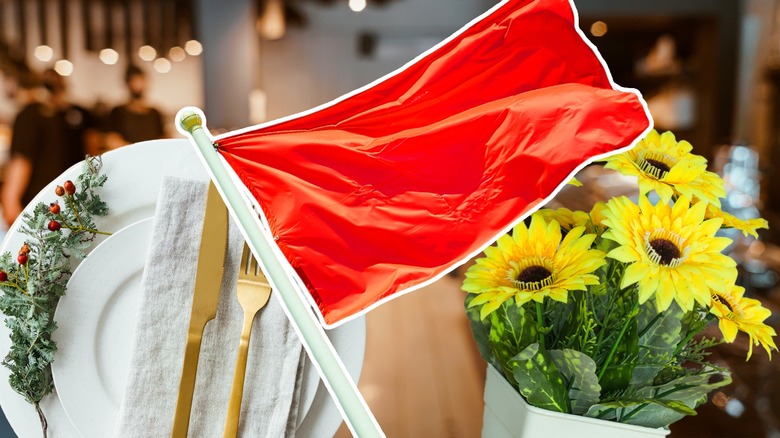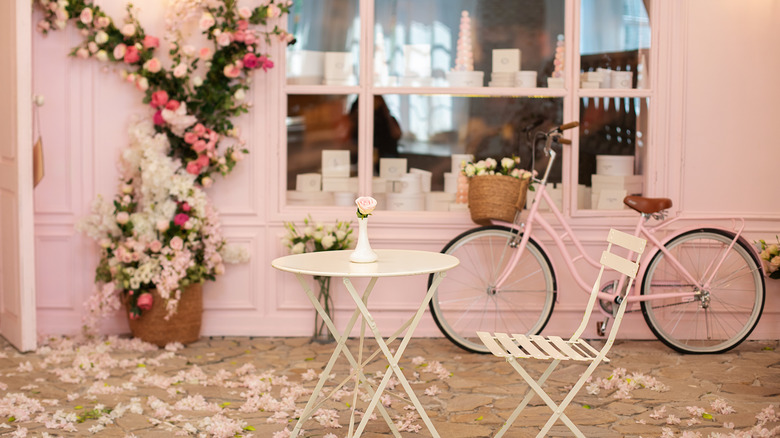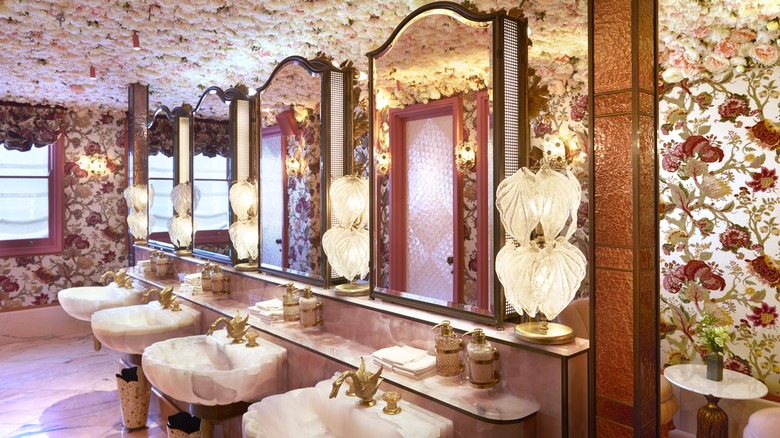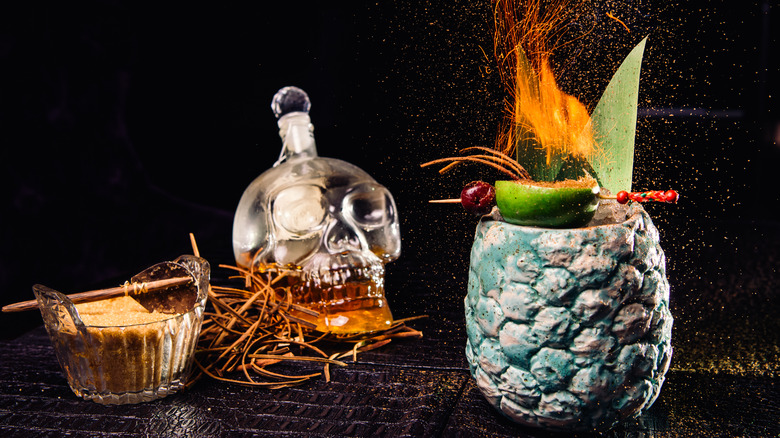The Top 3 Red Flags To Watch Out For At Restaurants In 2024
In the time of Yelp, Google reviews, and social media amplifying word of mouth like never before, it may seem like it's impossible to walk into a bad restaurant without knowing it first. How bad could it be — you wonder — when the place looks great, the menu promising, and the restaurant's Instagram feed is filled with a slew of beautiful influencers living it up? Alas, it happens all of the time, but there are three big red flags of 2024 to look out for in restaurants: fake flower walls and decorations, made-for-Instagram selfie bathrooms, and overly elaborate serving dishes.
A restaurant prioritizing some silly gimmick over the quality of food and dining experience isn't a new phenomenon by any means. In the '80s, there were the overly precious small plate restaurants (as seen in the anxiety-inducing food scenes from "American Psycho"), and the early 2000s saw a surge of molecular gastronomy boutiques, serving up frothed liver mousse and chicken pot pie essence.
On their face, the charming flower arches, selfie-ready bathrooms, and over-the-top presentations may not seem like dead giveaways for a bad restaurant, but they each speak to an establishment's prioritization of aesthetics and photogenic qualities over the most important part of any eatery: the food. Sure, you can probably find some decent restaurants with these elements. But for the most part, you should look for another spot if you see any of these warning signs.
The flaws of faux flowers
Have you noticed an abundance of blooms around your city lately? Maybe tucked into window boxes or elegantly towering over a cafe's door frame? Has it ever struck you as odd that your local restaurant seems to have tropical blooms year-round and no apparent way to make sure these flowers are watered, trimmed, or, well, alive? Although seemingly innocuous or even joyful and welcoming, these displays of fake flowers should put you off of a restaurant ASAP.
Using faux blooms over real ones is not just a problem because it's bad for the environment (as those plastic flowers aren't going to look pretty forever and will end up in a landfill eventually). Fake flowers, trees, and leaves are red flags because they also show a certain laziness from the owners and restaurant managers. They indicate that whoever's in charge doesn't want to spend time maintaining actual plants in the restaurant — if they aren't willing to water a potted plant a few times a week, why would they be willing to do more than the bare minimum to keep the restaurant clean?
Have you ever considered how they clean those fake plants each night? They probably don't, in all reality. Whether the fake flowers are posted around the outer archway, sat in pots near the entryway, or anchored to the ceiling, those bad boys are gathering up dust, grease, and grime — and it's floating down all around you every time they're disturbed, even if you can't see it.
Don't get caught up in a selfie sesh
When you think of what to look for in a bathroom, the words "clean" and "two-ply" likely come to mind. But in recent years, it seems lavatories need to provide at least that and more — the chance for a show-stopping selfie. To be clear, not all restaurants with Instagrammable bathrooms are slop shops; in fact, many high-quality establishment bathrooms are an extension of the design philosophy. But sometimes, a funkily-decorated bathroom is just a trap for unsuspecting diners.
One way to tell if you're being selfie-bathroom-baited before you enter the restaurant is to look at its Instagram feed — does the social media page frequently repost photos of unbelievably beautiful people striking a pose in front of a well-lit mirror or does it actually describe itself as having an "Instagrammable" bathroom in its bio? Check what posts the restaurant is tagged in on TikTok and Instagram, too. If you see lots of people focusing on the wallpaper in the loo or the oversized mirror rather than the food being served, you've spotted a selfie trap.
You should also take note of the decor in general. Does it tell a story about the restaurant, perhaps its history or the cuisine it offers? Or does it look like someone spun a wheel to get a trending chain of keywords like "palm beach-disco-bachelorette?" Hodge-podge, trendy themes that don't convey anything about the restaurant or its food are also good indicators of which restaurants to avoid.
Novelty glassware and serving dishes
The final red flag to avoid is restaurants that serve food and drinks out of novelty glasses and dishes. This might sound like a bit of a fun-hating here, but novelty drinking glasses and added flair such as sparklers should be reserved for sacred nights at chain restaurants that pump Vegas-levels of theatrics into their dining experience — we're talking Margaritaville, Señor Frog's, Bubba Gump, and their ilk.
If a restaurant uses these bits, it's often a way to cover up mediocre food and overpriced drinks, all slurped up by the masses from a light-blinking bendy straw. At one restaurant in Miami, for instance, you can eat candy floss (yes, the same thing you get at the carnival for a couple of bucks) straight off of an old mannequin head for about $40.
You should also be wary of other novelty serving dishes for basic items. Recently, in central London, a Mother's Day special included a tea tower with grilled chicken and tortilla chips on one tier plus what looked to be mozzarella sticks and toast on the others. Why pay a premium to see a Chili's appetizer sampler on top of a tea tower? If a restaurant offers anything other than an actual tea service on a tiered tray, it's best to take your business elsewhere. One last example would be a place like a charcuterie board-only establishment that piles crackers, cheese, and dried fruit on a platter, then charges you restaurant prices for items you could get at any Trader Joe's.



